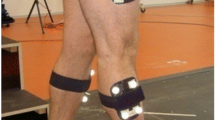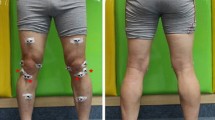Abstract
Purpose
The purpose of the study was to investigate the biomechanics of walking and of the knee joint in the acute phase of ACL injury.
Methods
We examined 18 patients with acute ACL injuries and 20 healthy adults as controls. The biomechanics of the knee joint and of walking was assessed by 5 inertial sensors fixed with special cuffs to the lower back, the lower third of the thigh, and the lower third of the shank of the right and left legs. The movements and temporal characteristics were recorded while the subject was walking 10 m at a comfortable pace. Based on the results of examination, the patients were divided into two groups: with severe function impairment (6 patients) and with moderate function impairment (12 patients).
Results
It was found that in the first days post-trauma, not only the knee function was reduced, but the function of the entire lower limb as well. This led to a functional asymmetry. The kinematics of movements in the joints changed in accordance with slower walking. The walking became not only slower, but it was also associated with a decreased impact load in the weight acceptance phase. At later dates, the functional impairments were less pronounced. The total range of flexion motion did not exceed 20 degrees in the first group and 55 degrees in the second one. The injured joint developed functional immobilization within the first days post-injury. This was a guarding response by additional muscle strain to prevent unusual and limit physiological movements in the knee joint. The movements in the knee joint while walking were of small amplitude, rocking, and occurred only under load. The amplitude of the main flexion in the swing phase was reduced.
Conclusion
The stage of an ACL injury should be assessed not only based on the time post-trauma, but also taking account of the functional parameter—the knee range of flexion while walking. According to our findings, the only factor that had influenced the functional condition of the KJ was the duration of joint immobilization after trauma.


Similar content being viewed by others
References
Kaeding CC, Léger-St-Jean B, Magnussen RA (2017) Epidemiology and diagnosis of anterior cruciate ligament injuries. Clin Sports Med 36(1):1–8. https://doi.org/10.1016/j.csm.2016.08.001Epub 2016 Oct 4
Gornitzky AL, Lott A, Yellin JL et al (2015) Sport-specific yearly risk and incidence of anterior cruciate ligament tears in high school athletes: a systematic review and meta-analysis. Am J Sports Med
Risberg MA, Lewek M, Snyder-Mackler L (2004) A systematic review of evidence for anterior cruciate ligament rehabilitation: how much and what type? Phys Ther Sport 5:125–145
Boden BP, Dean GS, Feagin JA et al (2000) Mechanisms of anterior cruciate ligament injury. Orthopedics 23:573–578
Joseph AM, Collins CL, Henke NM et al (2013) A multisport epidemiologic comparison of anterior cruciate ligament injuries in high school athletics. J Athl Train 48:810–817
Dae-Hee, Lee, Jin-Hyuck, Lee, Sung-Eun, Ahn, and Min-Ji, Park. (2015) Effect of time after anterior cruciate ligament tears on proprioception and postural stability. Published online doi: https://doi.org/10.1371/journal.pone.0139038
Strobel MJ (2002) Manual of arthroscopic surgery. Springer Science & Business Media, p 369
Hurd WJ, Snyder-Mackler L (2007) Knee instability after acute ACL rupture affects movement patterns during the mid-stance phase of gait. J Orthop Res 25:1369–1377
Rudolph KS, Axe MJ, Buchanan TS, Scholz JP, Snyder-Mackler L (2001) Dynamic stability in the anterior cruciate ligament deficient knee. Knee Surg Sports Traumatol Arthrosc 9:62–71
Gardinier ES, Manal K, Buchanan TS, Snyder-Mackler L (2013) Altered loading in the injured knee after ACL rupture. J Orthop Res 31(3):458–464. https://doi.org/10.1002/jor.22249Epub 2012 Oct 23
Bacchini M, Cademartiri C, Soncini G (2009) Gait analysis in patients undergoing ACL reconstruction according to Kenneth Jones’ technique. Acta Biomed 80(2):140–149
Elbaz, A., Cohen, M.S., Debbi, E.M., Rath, U., Mor, A., Morag, G., Beer, Y., Segal, G., Debi, R. (2014) A noninvasive biomechanical treatment as an additional tool in the rehabilitation of an acute anterior cruciate ligament tear: a case report. SAGE open med case rep., 8;2:2050313X13519978. doi: https://doi.org/10.1177/2050313X13519978
Button K, van Deursen R, Price P (2005) Measurement of functional recovery in individuals with acute anterior cruciate ligament rupture. Br J Sports Med 39(11):866–871 discussion 866-71
Leporace, G., Batista, L.A., Muniz, A.M., Zeitoune, G., Luciano, T., Metsavaht, L., Nadal, J. (2012) Classification of gait kinematics of anterior cruciate ligament reconstructed subjects using principal component analysis and regressions modelling. Conf Proc IEEE Eng med biol Soc., 6514-7. doi: https://doi.org/10.1109/EMBC.2012.6347486
Akhpashev, A.A., Zagorodniy, N.V., Kanaev, A.S., Kaurkin, S.N., Skvortsov, D.V. (2016) Knee joint gait function in patients with ACL rupture before and after the surgery. Travmatologija i ortopedija Rossii [traumatology and orthopedics of Russia], (2):15-24. (in Russ.) DOI:https://doi.org/10.21823/2311-2905-2016-0-2-15-24
Sonnery-Cottet B, Saithna A, Quelard B, Daggett M, Borade A, Ouanezar H, Thaunat M, Blakeney WG (2019) Arthrogenic muscle inhibition after ACL reconstruction: a scoping review of the efficacy of interventions. Br J Sports Med 53(5):289–298. https://doi.org/10.1136/bjsports-2017-098401. Epub 2018 Sep 7 Review
Author information
Authors and Affiliations
Corresponding authors
Ethics declarations
Conflict of interest
The authors declare that they have no conflict of interest.
Ethical approval
This article does not contain any studies with human participants or animals performed by any of the authors.
Additional information
Publisher’s note
Springer Nature remains neutral with regard to jurisdictional claims in published maps and institutional affiliations.
Rights and permissions
About this article
Cite this article
Skvortsov, D., Kaurkin, S., Goncharov, E. et al. Knee joint function and walking biomechanics in patients in acute phase anterior cruciate ligament tear. International Orthopaedics (SICOT) 44, 885–891 (2020). https://doi.org/10.1007/s00264-020-04485-1
Received:
Accepted:
Published:
Issue Date:
DOI: https://doi.org/10.1007/s00264-020-04485-1




